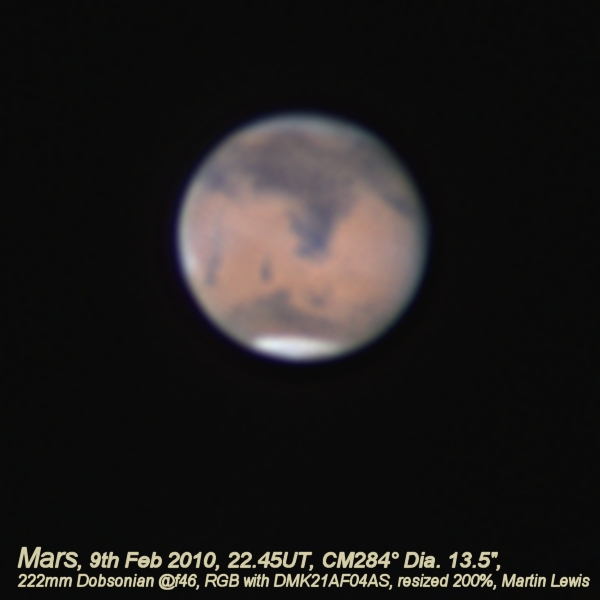火星 ALPO-Japan Latest

Mars Image 2010/02/09(UT)
Martin R Lewis,Jean Jacques Poupeau,Paul G. Abel,Efrain Morales Rivera,Gerald Stelmack,Paulo Casquinha
Martin.L,J.J.Poupeau,P.Abel,E.Morales,G.Stelmack,P.Casquinha
|
Martin R Lewis (222mm Newton) |
Managed to get a single gap in the cloud of just enough length to get a Red,a Green and a Blue image. Seeing was the best of the apparition when looking through gaps in fast-moving low cloud!
Nice faint band of bluish haze across centre of planet and across Syrtis Major.
 [Martin R Lewis: Hertfordshire United Kingdom]
[Martin R Lewis: Hertfordshire United Kingdom]
|
Jean Jacques Poupeau (350mm Cassegrain) |
The transparency was average and the wind was sometimes annoying.
Temperature : -2.5°C
 [Jean Jacques Poupeau : Pecqueuse France]
[Jean Jacques Poupeau : Pecqueuse France]
|
Paul G. Abel(203mm Newton) |
Mars Observation (09/02/10) 1911UT-2254UT
Mars is at an observable altitude by 1900UT,and is very prominent in the night sky. Initially the skies were clear and transparent,but alas,this did not last long and in the end observations were made through gaps in the cloud cover (which was frequently total.) When breaks in the cloud did occur,seeing was around AIII and reached AII on a number of occasions. A disk drawing and intensity estimates were made using a power of 312x.
Drawing A: Bright NPC prominent,the cap appears to be slightly smaller in size since the last observation? There are definite brighter and darker regions within the NPC,the sublimation must surely be well underway by now.
Lowell Band not as prominent tonight and faded into the Utopia,and Boreosyrtis regions. The base of Utopia and Boreosyrtis appear to be fairly dark. Boreosyrtis itself was quite a dark region with perhaps a streak leading away from it. Nodus Alcyonius appears are a dark streak. A lightish streak present in Dioscuria region.
On the proc. side,Elysium is present and brightest in the north. Both Aetheria and Phlegra present as dusky brownish streaks,Mare Cimmerium present on the Proc,. edge of the disk,two dark projections were observed in good conditions. The immediate area underneath Cimmerium (Aeolis?) was very bright and a whitish pink colour. Hespieria manifested itself as a dusky region between Cimmerium and the Mare Tyrrehenum.
The Mare Tyrrhenum was rather dark and had a distinct boundary from the lighter Hesperia region. Syrtis Major present on fol. side of the disk- many fine details here. In particular the region was darkest at the base and along it's boundary edges. I strongly suspected an equatorial cloud since the equatorial features seemed a little lighter and slightly obscured. A bluish tinge perhaps present over Sytris Major and in the extreme south.
Hellas quite unusual- the Mare Hadriacum was dark and prominent,but the Hellas basin itself was rather vague and ill-defined. Indeed,Electris and Eridania seemed to be brighter.
Drawing B: Intensity Estimates (BAA Scale) made in unfiltered light.
By 2254UT,clouds have returned once more,and by 2306UT,cloud cover was complete- there seemed to be

[Paul G. Abel:Leicester:United Kingdom]
|
Efrain Morales Rivera(300mm SC)
|
2010/02/09 04:16ut
LX200ACF 12 in. F30
DMK21AF04
TeleVue 3x
Astronomik LRGB
Baarder IR/UV filter
Seeing 7/10 8/10
 [Efrain Morales Rivera Aguadilla:Puerto Rico]
[Efrain Morales Rivera Aguadilla:Puerto Rico]
|
Gerald Stelmack(235 mm SC) |
2010/02/09 (GS Mars-2010-02-09) 05:43 UT
CM=34.88 Mag = -1.11 Dia = 13.73"
Phase = 0.99 C9.25 (235 mm) DMK 21AF04.AS Astronomik LRGB Type 2 Seeing: 7/10
 [G.Stelmack : Canada]
[G.Stelmack : Canada]
|
Paulo Casquinha (C14 355mmSC) |
taken in fair seeing

(site: 38.567 N /8.933 W Alt 124 m)
[Paulo Casquinha Palmela,Portugal]


[Martin R Lewis: Hertfordshire United Kingdom]
[Jean Jacques Poupeau : Pecqueuse France]

[Efrain Morales Rivera Aguadilla:Puerto Rico]
[G.Stelmack : Canada]

 ALPO-Japan Latest
ALPO-Japan Latest

 Mars Section
Mars Section